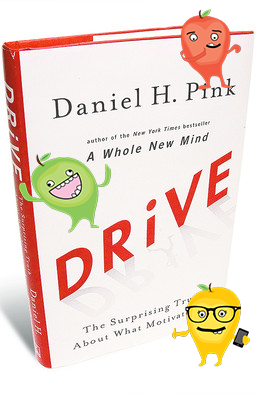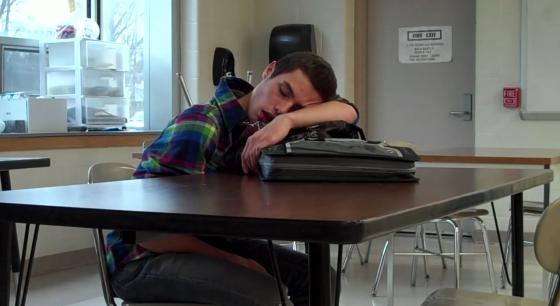
For those of you who haven’t read Daniel Pink’s Drive, it’s an eye-opener that debunks the belief that the best way to motivate ourselves is through external rewards like money (or straight As, in our case). Rather, the secret to true, sustained motivation and satisfaction is a internal human need to control their own lives, to get better, and to contribute to the world around us.
Drive in education
As I read through the book looking for ideas to conclude our student engagement month, I found that Pink’s research lined up pretty well to the concepts we talk about on this blog. While his focus is on business and how they operate under the belief that “the way to improve performance, increase productivity, and encourage excellence is to reward the good and punish the bad,” it’s not that far from how traditional school worked. Students who fared well on tests got As and students who didn’t do well got Fs, and everything in between. We’ve traditionally motivated students with their grades.
But we know that tests simply don’t say everything about how a student is learning—it measures his/her ability to select the right answer at that moment in time. As educators and learners ourselves, we know there is cramming, memorizing, and even cheating. There are ways to ace a test without mastering the material. You’ll achieve desired results in the short term, but it’s pretty detrimental in the long run.
It’s far better to tap into an internal, or intrinsic, motivation than it is to rely on external motivators to achieve. In Drive, Pink breaks down intrinsic motivation to three key factors: Autonomy, Mastery, and Purpose. Here at Higher Order Teaching, we break that down for the classroom.
Autonomy
Autonomy in the classroom means that students have control of their own learning. It does not mean that students are free to learn and do whatever they please whenever they please. For example, our friend Mr. Rowe, a high school teacher, gives homework as practice for the lesson. Instead of grading homework, students use traditional homework as practice and a basis for discussion in class. This way, students are doing their homework for the sake of learning, and not scrambling to get homework done for the sake of getting a check mark.
Pink argues that curiosity and self-direction are hard-wired into human nature. “Have you ever seen a six-month-old or a three-year old whos not curious and self-directed?” The curiosity is our “default setting.” The inertia and reluctance we find is a result of the prodding and rewarding as motivation. Pink says management (in our case teaching) isn’t about responding to this assumed natural state of inertia, but rather it’s about producing an environment for us to get back to that curious and self-directed state.
Mastery
In Pink’s book, mastery is “the desire to get better and better at something that matters.” In education, we call it grit. The idea of grit and mastery in education is to learn something to better yourself. For example, Parul’s high school math teacher taught her class math at a very high level—a level much more challenging than anything her class would see on the SATs—because that was the level of math he expected out of them. “His basic philosophy was that if we understood the fundamentals and prepared at an extremely rigorous level, we didn’t have anything to worry about when it came to standardized assessments,” she writes.
As we all know, math has infinite applications that extend far beyond any single test. Teaching to a test like the SATs is affirming to the students that the test is what the students’ end game is. While grades, like money, are necessary motivators, they are not sustainable incentives. It’s the difference between getting an A in French class and learning to speak French fluently, says Pink. While both goals lead to achievement, only the second one leads to mastery.
Purpose
According to Pink, purpose is contributing to something bigger than ourselves. It deals with relevance and playing a part in the world around us. Did you get into teaching because of the paycheck? Or because you have dedicated yourself to making tomorrow a better place? My guess is that those who answered “paycheck” are constantly checking the time and looking forward to the end-of-the-day bell ringing more than any student. For those of you who dedicated themselves to shaping young minds for our future, my guess is that you’ve worked countless extra hours without a peep—because it means something to you.
For our students, purpose comes in the form of relevance. I’ll be the first to admit I moaned and groaned anytime I was assigned a paper in high school. Luckily, teachers have figured this out. To give students a “purpose” for learning how to write, teachers are now asking their students to look up job postings, college applications, apartment leases that all require writing. This way, students know that they’re learning something that is necessary for their future. Show me how something matters to my life and I’m in.
Conclusion
I highly recommend this book to anyone who is in charge of other people. It’s the scientific explanation why micromanagement isn’t good for anything; why cramming and cheating and learning for the test is bad for the long term, and why we all want to contribute to something bigger than ourselves. So, are you trying to fill a bucket or light a fire?
Animated summary of the book.







